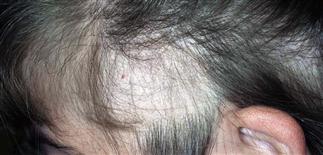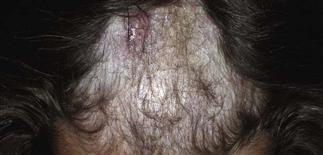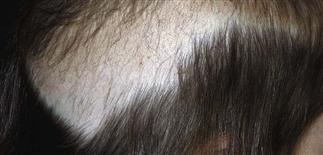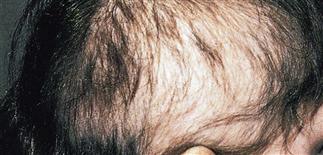152
Trichotillomania

Hair loss occurs in patches that are usually smooth, without inflammation, and sharply angulated. In this case, the loss is nearly complete in a round patch, mimicking alopecia areata.

Note the bizarre shape of the hair loss, the general retention of the frontal hairline, and some short broken hairs.

A sharply angulated pattern of alopecia is a telltale sign of an ‘outside job’. As in alopecia areata, the scalp is not inflamed, not scaling, and there is no evidence of scarring.

As in the other figures, the hair loss in trichotillomania may not be complete, with some broken hairs evident, and some patchy regrowth.
DESCRIPTION
Recurrent pulling of one’s hair, resulting in significant hair loss. Urge to pull hair is overwhelming; after hair pulling, anxiety is relieved temporarily. It may involve many hours each day of pulling the hair, or thinking about pulling it. Often the ‘puller’ does not admit to this habit.
HISTORY
• Trichotillomania is a habit tic most commonly found in young children. It is also seen in adolescents and adults. • Female to male ratio is 2.5 : 1. • Hair is twisted around finger, pulled, and rubbed until it is extracted or broken. • Favorite sites are easily reached areas: frontoparietal scalp, eyebrows, eyelashes. • First manifests during inactive periods, perhaps while watching television or before falling asleep. • Parents seldom notice the behavior. • Often associated with underlying anxiety, depression, low self-esteem. • Can be a chronic problem and often resolves spontaneously. • Affected area has an irregular angulated border, and the density of hair is greatly reduced, but the site is never bald as in alopecia areata. • Multiple visits to providers and specialists seeking a diagnostic answer are typical for this condition; a biopsy can be helpful and supportive of this diagnosis.
PHYSICAL FINDINGS
• There is a patch of hair loss with an irregular, angulated border. • Hair density is greatly reduced; the involved area is not completely bald and smooth, as in alopecia areata. • Short broken hairs of varying lengths are randomly distributed in involved site. • Potassium hydroxide test rules out non-inflammatory tinea capitis. • Plucked hair shows no telogen hair roots (100% in the active growing anagen phase). • Gentle hair traction produces no more hair loss. • Skin biopsy reveals a marked increase in catagen hairs.
TREATMENT
• Treatment often delayed, or not sought, because of embarrassment. • Response is best to combination therapy including psychopharmacology, psychotherapy, and behavior modification (such as habit substitution), rather than psychotherapy alone. • The child’s attention should be diverted when hair is being pulled. • Parents and physician should be accepting and supportive rather than judgmental and punitive. • Extensive involvement or persistence requires psychiatric evaluation. Psychotherapy can be helpful. • Trichotillomania shares features with obsessive-compulsive disorder, including response to medication. • Clomipramine (Anafranil), fluoxetine (Prozac), and pimozide (Orap) can be effective; however, not all patients respond fully to psychopharmacology alone.







